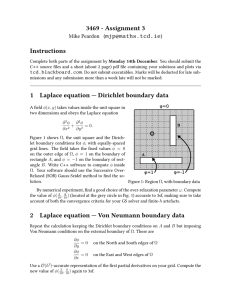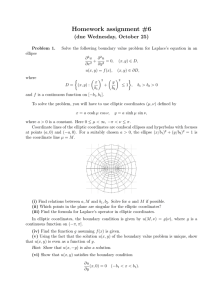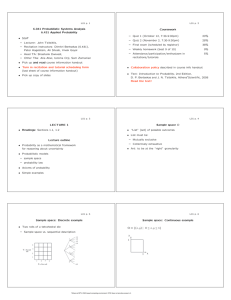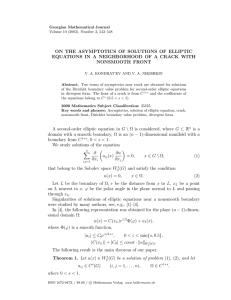ON THE DIRICHLET PROBLEM FOR A SECOND ORDER ENTIRE DOMAIN BOUNDARY
advertisement
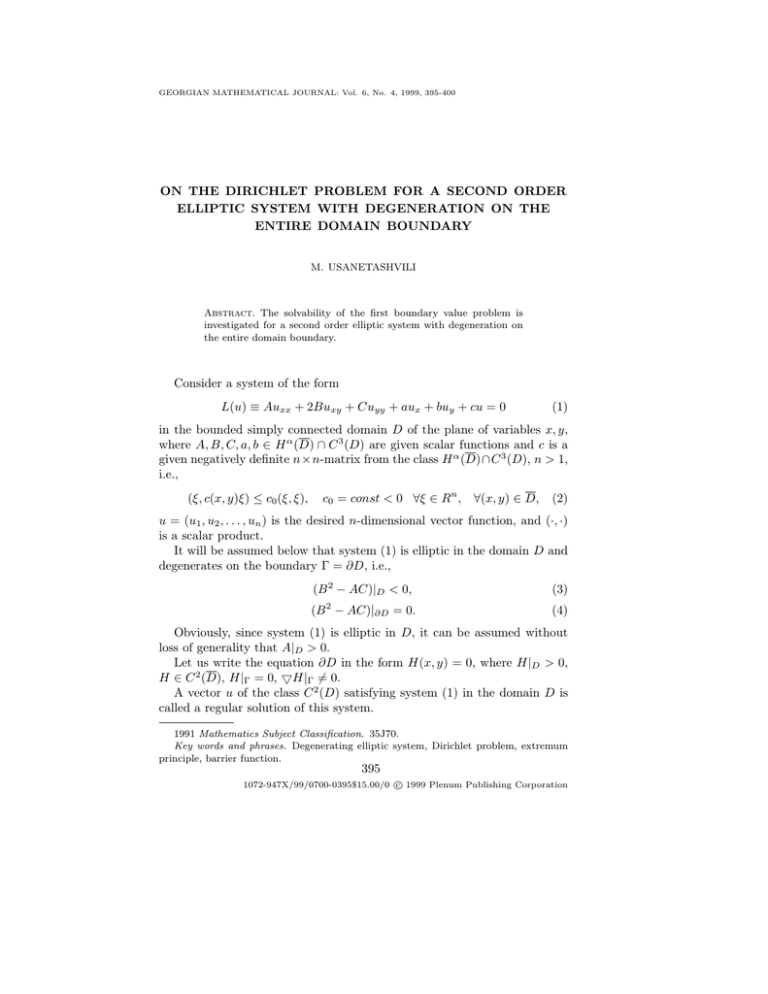
GEORGIAN MATHEMATICAL JOURNAL: Vol. 6, No. 4, 1999, 395-400
ON THE DIRICHLET PROBLEM FOR A SECOND ORDER
ELLIPTIC SYSTEM WITH DEGENERATION ON THE
ENTIRE DOMAIN BOUNDARY
M. USANETASHVILI
Abstract. The solvability of the first boundary value problem is
investigated for a second order elliptic system with degeneration on
the entire domain boundary.
Consider a system of the form
L(u) ≡ Auxx + 2Buxy + Cuyy + aux + buy + cu = 0
(1)
in the bounded simply connected domain D of the plane of variables x, y,
where A, B, C, a, b ∈ H α (D) ∩ C 3 (D) are given scalar functions and c is a
given negatively definite n×n-matrix from the class H α (D)∩C 3 (D), n > 1,
i.e.,
(ξ, c(x, y)ξ) ≤ c0 (ξ, ξ),
c0 = const < 0 ∀ξ ∈ Rn , ∀(x, y) ∈ D,
(2)
u = (u1 , u2 , . . . , un ) is the desired n-dimensional vector function, and (·, ·)
is a scalar product.
It will be assumed below that system (1) is elliptic in the domain D and
degenerates on the boundary Γ = ∂D, i.e.,
(B 2 − AC)|D < 0,
2
(B − AC)|∂D = 0.
(3)
(4)
Obviously, since system (1) is elliptic in D, it can be assumed without
loss of generality that A|D > 0.
Let us write the equation ∂D in the form H(x, y) = 0, where H|D > 0,
H ∈ C 2 (D), H|Γ = 0, 5H|Γ 6= 0.
A vector u of the class C 2 (D) satisfying system (1) in the domain D is
called a regular solution of this system.
1991 Mathematics Subject Classification. 35J70.
Key words and phrases. Degenerating elliptic system, Dirichlet problem, extremum
principle, barrier function.
395
c 1999 Plenum Publishing Corporation
1072-947X/99/0700-0395$15.00/0
396
M. USANETASHVILI
Let us pose the Dirichlet problem for the system (1). Find, in the domain
D, a regular solution of equation (1) which is continuous in the closed
domain D and satisfies the boundary condition
u|Γ = f,
(5)
where f = (f1 , f2 , . . . , fn ) is a given continuous vector function on Γ.
Note that the Dirichlet problem was investigated in [1], [5] for some
specific classes of second order elliptic systems.
When investigating the Dirichlet problem, the following two cases are to
be distinguished:
6 0,
(AHx2 + 2BHx Hy + CHy2 )|Γ =
(AHx2
+ 2BHx Hy +
CHy2 )|Γ
= 0.
(6)
(7)
Remark 1. Equality (4) together with condition (6) imply that equation
(1) parabolically degenerates on Γ and, at every point of the boundary,
the tangential direction does not coincide with the characteristic direction.
Conditions (4) and (7) are equaivalent to the fact that at the points of the
boundary either the equation order degenerates or parabolic degeneration
takes place and the characteristic direction coincides with the tangential
direction.
When condition (3) is fulfilled,
p the following extremum principle [1] takes
place: the norm R(x, y) = (u, u) of a regular solution u of system (1)
in the domain D cannot attain a nonzero relative maximum at any point
(x, y) ∈ D.
The uniqueness of the solution of the Dirichlet problem for system (1)
follows from the above-mentioned extremum principle.
To construct the solution of the Dirichlet problem we shall use the Wiener
method. Using arbitrary vector functions f of the class C(D) ∩ C 3 (D) that
are continuously extendable onto D, let us construct a sequence of domains
Dh increasing as h → 0 and having a smooth boundary of the class C 2 such
that Dh1 ⊂ Dh2 for h1 > h2
Let uh (x, y) be the solution of the Dirichlet problem for system (1) in
Dh that coincides with f on the boundary of Dh . As is known, the solution
uh (x, y) exists and is unique, since in Dh system (1) does not degenerate
[6]. By virtue of (2) in Dh we have the inequality kuh k ≤ M , where M =
max kf (x, y)k in D. Let us show that the set of functions {uh (x, y)} is
compact within D. Indeed, let h0 be an arbitrary fixed value of h. For
h ≤ h0 the set {uh (x, y)} will be uniformy bounded in Dh0 ,
kuh (x, y)k ≤ M.
(8)
SECOND ORDER ELLIPTIC SYSTEM WITH DEGENERATION
On the other hand, we have the representation [6]
Z
uh (x, y) =
Kh0 (x, y; s)uh (s)ds, (x, y) ∈ Dh0 ,
397
(9)
∂Dh0
where the kernel is itself a regular solution of system (1) with respect to the
variables x, y.
This immediately implies the equicontinuity of the family {uh (x, y)}.
From (8) and (9) we obtain the equicontinuity of the set of function {uh }
in Dh0 . According to Arcela’s theorem [1] the latter set may contain a
subsequence uniformly converging to some function u(x, y) which by virtue
of (9) is the solution of system (1) in the domain D. It remains to find out
whether the constructed solution coincides with f on Γ.
We shall show that in the case of (6) for each point Q ∈ Γ = ∂D
there exists a function v(x, y) called a barrier and possessing the following properties:
(a) being continuous
in some neighborhood of this point
ωQ = P ∈ D : |P − Q| < ; (b) being equal to zero at the point Q; (c)
v(x, y) > 0 in ωQ \Q; (d) everywhere in this neighborhood satisfying the
condition
L01 (u) ≡ Auxx + 2Buxy + Cuyy + aux + buy < 0.
In the considered case of (6) the function
v(x, y) = (x − x0 )2 + (y − y0 )2 + H β (x, y),
0 < β < 1,
can serve a barrier. Indeed, the function v(x, y) evidently satisfies the conditions (a), (b) and (c). Let us verify the condition (d). Substituting the
expression for v(x, y) into L01 (v), we obtain
L10 (v) =β(β − 1)H β−2 (AHx2 + 2BHx Hy + CHy2 ) +
+ βH β−1 (AHxx + 2BHxy + CHyy + aHx + bHy ) +
+ 2A + 2C + 2a(x − x0 ) + 2b(y − y0 ).
(10)
Hence we immediately conclude that by virtue of 0 < β < 1 there exists a
neigborhood σQ of the point Q such that L10 (v) < 0.
Since the function f (P ) is continuous, for given positive we can find a
0
⊂ σQ of the point Q such that the inequality
semicircular neighborhood σQ
0
, 0 < < 1,
kf (P ) − f (Q)k < , P ∈ σQ
(11)
be fulfilled.
Consider two functions v1 (P ) = + Kv(P ), K > 0, u∗h (P ) = uh (P ) −
0
0
f (Q), where P ∈ σQ
. In the domain ωh = σQ
∩ Dh , where h is a sufficiently
398
M. USANETASHVILI
small positive number, we have
sup
(x,y)∈ωh
L10 (uh∗ ) = L01 (uh ),
L01 (v) ≤ α0 = const < 0,
(12)
ku∗h kC(ωh ) ≤ 2M, M = max kf k.
(13)
D
We set g(P ) = (u∗h (P ), u∗h (P )), P ∈ ωh . By virtue of (3), (10), (12), (13)
and sufficiently large K we obtain
∗
∗
) + 2B(u∗hx , u∗hy ) + C(u∗hy , uhy
)] −
L01 (v1 − g) = KL01 (v) − 2[A(u∗hx , uhx
∗
−2(u∗h , Auhxx
+ 2Bu∗hxy + Cu∗hyy + au∗hx + bu∗hy ) ≤
≤ KL01 (v)−2(uh (P )−f (Q), L01 (uh )) = KL01 (v)−2(uh (P )−f (Q), −cuh ) ≤
≤ Kα0 − 2(f (Q), cuh ) = KL01 (v) + 2(uh , cuh ) − 2(f (Q), cuh ) ≤
≤ Kα0 + 2kf (Q)k kck kuh k ≤ Kα0 + 2M 2 kck < 0.
(14)
Let us now find out which sign of v1 − g takes place on the domain
boundary ωh ; ∂ωh = γh ∪ γ1h , where γ1h = ∂ωh ∩ ∂Dh , γh = ∂ωh \γ1h . By
virtue of (11) we have
g|γ1h = (uh (P ) − f (Q), uh (P ) − f (Q))|γ1h = k(f (P ) − f (Q)k2 < ,
v1 |γ1h = + Kv(P )|γ1h > +K min v(P ), g|γh ≤ 4M 2 .
(15)
γ1h
By (15), for sufficiently large K we have
(v1 − g)|γ1h = ( + Kv − g)|γ1h > + K
min
(x,y)∈γ1h
v−=K
min
(x,y)∈γ1h
v > 0,
(v1 − g)|γh = ( + Kv − g)|γh ≥ + K min v − 4M 2 > 0.
(x,y)∈γh
By (14) and (15) and applying the extremum principle we have [1] (v1 −
g)|ωh ≥ 0, i.e., g ≤ v1 throughout the domain ωh , or
(uh (P ) − f (Q), uh (P ) − f (Q)) ≤ + Kv(P ).
(16)
Due to the properties of the barrier v there exists δ = δ() > 0 such that
0
for kP − Qk < δ and P ∈ σQ
we have
Kv(P ) < .
From (16) and (17) we find that ku(P ) − f (Q)k ≤
which was to be proved.
Thus the following assertion is true.
(17)
√
2 for kP − Qk < δ,
Theorem 1. The Dirichlet problem (1), (5) always has a unique solution.
SECOND ORDER ELLIPTIC SYSTEM WITH DEGENERATION
399
When considering the case of (7) it will be assumed that in some neighborhood of the boundary Γ there is a representation
AHx2 + 2BHx Hy + CHy2 = H p G,
(18)
where p = const > 0, G is a positive, continuous and bounded function in
this neigborhood.
Lemma 1. If there exists a function W (P ), which is positive in D, uniformly converging to infinity as ρ(P, ∂D) → 0 and satisfying the inequality
L01 (W ) < 0, then system (1) has only a trivial solution in the class of
bounded vector functions in D.
Proof. Indeed, let u(x, y) be a bounded regular solution of system (1) in
D. Consider the expression L01 (W − (u, u)) = L01 (W ) − L01 ((u, u)). By
calculating L10 ((u, u)) we obtain
L10 ((u, u)) = 2[A(ux , ux ) + 2B(ux , uy ) + C(uy , uy )] +
+2(u, Auxx + 2Buxy + Cuyy + aux + buy ) ≥ 0,
(19)
since by virtue of (3), A|D > 0, and the Cauchy–Bunyakovskii inequality
we have
A(ux , ux ) + 2B(ux , uy ) + C(uy , uy ) ≥ Akux k2 − 2|B||(ux , uy )| + Ckuy k2 ≥
2
√
√
√ √
Akux k − Ckuy k ≥ 0.
≥ Akux k2 − 2 A Ckux k · kuy k + Ckuy k2 =
The conditions of Lemma 1 and (19) lead to L10 (W − (u, u)) < 0, which
by virtue of the extremum principle gives that the function W − (u, u)
cannot have a negative minimum in D, and since its limit value on the
boundary are positive, we have (u, u) ≤ W throughout D. Hence, since
> 0 is arbitrary, it folows that kuk = 0 in D.
Taking into account (18), expression (10) can be rewritten as
L01 (v) = β(β − 1)H β+p+2 G + βH β−1 L01 (H) + 2A + 2C +
+2a(x − x0 ) + 2b(y − y0 ).
Theorem 2. If (2) holds and one of the conditions (i) 0 < p < 1; (ii) p =
1, (1−IG−1 )|Γ > 0, I = L01 (H); (iii) 1 < p < 2, I|Γ ≤ 0; (iv) p ≥ 2, I|Γ < 0
is fulfilled, then the Dirichlet problem has a solution.
Proof. The existence of a solution of the Dirichlet problem follows from the
existence of a barrier function. For 0 < p < 1 the sign of L01 (v) coincides
with the sign of β(β − 1)H p+β−2 , i.e., L01 (v) < 0. If the condition (ii) is
fulfilled, then the sign of L10 (v) coincides with the sign of β[(β−1)G+I]H β−1
and, assuming that β < (1 − IG−1 )|Γ , we shall have L01 (v) < 0. Under the
400
M. USANETASHVILI
condition (iv) the sign of L01 (v) coincides with the sign of βH β−1 I, i.e.,
L10 (v) < 0.
Lemma 2. Let any one of the conditions (i) p = 1, IG−1 |Γ ≥ 1; (ii) 1 <
p < 2, I|Γ > 0; (iii) p ≥ 2, I|Γ ≥ 0 be fulfilled and, at each point P0 ∈ D,
either the function Φ(P0 ) = (Agx2 + 2Bgx gy + Cgy2 )(P0 ) =
6 0, where g ∈
C 2 (D), g > 1, or Φ(P0 ) = 0 and c(P0 ) < 0. Then there exists a function
W (x, y) possessing the following properties: (a) W (P ) > 0, P ∈ D, (b)
W (P ) = +∞; (c) L01 (W ) < 0, P ∈ D [7].
lim
ρ(P,∂D)→0
We can take as W , for instance, an expression W (x, y) = − log H(x, y) −
g n (x, y) + K0 for some natural n and positive constant K0 .
Lemmas 1 and 2 give rise to the following assertion.
Theorem 3. When the conditions of Lemma 2 are fulfilled, system (1)
has only a trivial solution in the class of bounded vector functions in D.
References
1. A. V. Bitsadze, Some classes of partial differential equations. (Russian) Nauka, Moscow, 1991.
2. V. P. Didenko, The first boundary value problem for some elliptic systems of differential equations with degeneration on the boundary. (Russian)
Sibirsk. Mat. Zh. 6(1965), No. 4, 814–831.
3. V. P. Didenko, On some elliptic systems degenerating on the domain
boundary. (Russian) Dokl. Akad. Nauk SSSR 143(1962), No. 6, 1250–
1253.
4. E. A. Baderko, To the Dirichlet problem for degenerating elliptic
systems. (Russian) Differentsial’nye Uravneniya 5(1969), No. 1, 131–140.
5. O. M. Jokhadze, Extremum principle for some classes of second order
elliptic and parabolic systems. (Russian) Nonlocal boundary problems and
related problems of mathematical biology, informatics and physics. (Abstr.
intern. conf., 1996), 30–31, Kabard.–Balkarian Center of Russian Academy
of Sciences, Nalchik, 1996.
6. A. V. Bitsadze, Boundary value problems for elliptic equations of
second order. (Russian) Nauka, Moscow, 1966.
7. M. A. Usanetashvili, On the solvability of the Dirichlet problem for
second order elliptic equations with degeneration on the entire boundary.
(Russian) Differentsial’nye Uravneniya 21(1985), No. 1, 145–148.
(Received 18.12.1996)
Author’s address:
Department of Mathematics (99)
Georgian Technical University
77, M. Kostava St., Tbilisi 380075, Georgia
